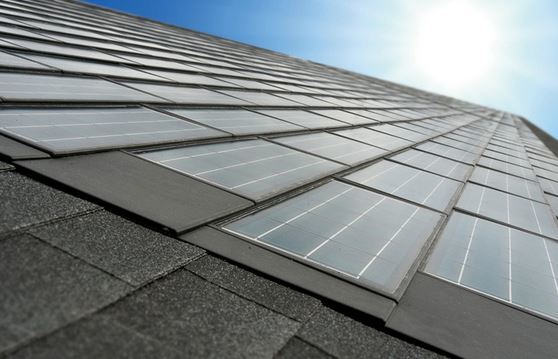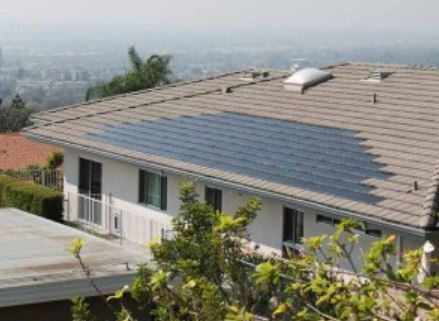Elon Musk made headlines recently when he announced that the newly merged Tesla and SolarCity would be building solar roofs - not solar panels on roofs, but roofs made of solar panels. These would be intended for new constructions and replacement roofs. He provided no details of the design, so I thought I'd speculate on some possible features. Please add your thoughts in the comment section below.
Aesthetics and Performance
Musk said that many people don't go solar because they don't like the way it looks. I'm not sure that anyone has conducted a scientific survey to test that assumption, but it seems logical, so we'll go with it. The new roof needs to look good as well as generate electricity. How does that happen? In stages.
A few years ago, Dow released its Powerhouse line of solar shingles - roof shingles with built-in thin-film photovoltaic panels. Although they're shaped like asphalt shingles and lie flat on the roof, they still have the unmistakable look of PV panels. Also, thin-film PV modules have lower efficiency and shorter lifespans, which doesn't help the cost/benefit tradeoff. Apparently, Powerhouse didn't catch on; Dow is discontinuing the product, as of June 2016.

SunTegra makes solar panels that integrate into the roof, essentially replacing the shingles rather than being mounted to a rack on the roof. Although these panels are efficient monocrystalline PV cells and they sit flush with the roof, they're clearly visible as something that "doesn't belong." Musk wants a roof that looks like a roof. This doesn't fit the bill.

I recently wrote about Sistine Solar, an upstart company that's making aesthetically pleasing solar panels that look like roof shingles and are available in virtually any color or pattern. The company says that its patent-pending process uses a very thin layer of color that looks great but allows most of the sunlight to pass through it, trading off a little efficiency for a lot of beauty. SolarCity already makes one of the highest efficiency solar panels on the market today, so a marriage between SolarCity and Sistine Solar could produce a high-performance panel that looks like a roof. If I were a matchmaker, I'd introduce these companies to each other. "You two would make a great couple!"
Storage
Musk's plan is to integrate storage - likely some variation of the Powerwall - with every PV system. This pretty much rules out the use of microinverters, which convert DC to AC at the panel level. Instead, an intelligent, grid-tied string inverter with a built-in battery charge controller and the ability to automatically disconnect from the grid during a power failure (anti-islanding) will be required.
Safety
Rooftop solar presents a safety issue for firefighters: PV panels are always live when they're receiving light, so a building that's on fire during the day could pose a double-threat to rescue workers. Most jurisdictions require a safety perimeter around the edges of the roof, giving firefighters room to navigate. The SolarCity roof would need the same boundary, but assuming the panels are "invisible," it's difficult to know exactly where that boundary will be. Among all the challenges of a fully-integrated solar roof, I think this one is the biggest. How would you address it?
Durability and Longevity
Although PV panels are made of rigid silicon and covered with glass, they're quite durable. They're designed to survive reasonable hailstorms - pretty much anything that normal roof shingles can withstand. And while we usually discourage people from walking on them, the panels on the MS Tûranor, a solar powered boat, can be tread upon. This shouldn't be a problem for a solar roof. Friction, or the lack thereof, will be an issue, however, since most roofs are angled. The surface of a solar roof could be similar to that of a Solar Roadway. (Frankly, I've never been a fan of the Solar Roadway concept, but maybe one aspect of its technology can be useful in solar roofs.)
Today's PV panels are typically guaranteed for 25 years, although most can generate power well beyond that. The shingles on a roof usually last 25 years as well, but assuming the shingles have done their jobs, the underlying structure of the roof should last the life of the house. This is where the integrated solar roof could be problematic. It's one thing to reshingle a roof every 25 years, but nobody wants to replace the structure at the same time. I'm picturing a structural component with a snap-in solar module; it's easy to install and the structure can remain intact when the PV modules need to be replaced. This would also help in the rare cases where a PV module fails and needs replacement before its expected end of life.
Cost
The first Tesla vehicles were priced well out of the range of average consumers. The idea was to develop and perfect the technology using affluent, socially-conscious customers as "test subjects," and use that experience to eventually produce something that's within reach of the middle class. Will that also be the approach here? Obviously, Musk wants to electrify as many rooftops as possible, but it could take a couple of generations (of technology, not people) before solar roofs are affordable for the masses. One thing that could help is that a solar rooftop would be a fully-integrated system, which would lower the design, installation, and permitting costs - the so-called "soft costs."
What Would Tesla Do?
"... it is only through enlightenment that we become conscious of our limitations. Precisely one of the most gratifying results of intellectual evolution is the continuous opening up of new and greater prospects." - Nikola Tesla
Elon Musk named his car company after Nikola Tesla because the inventor was more interested in helping humanity than achieving wealth and fame. Musk, having earned prosperity and notoriety in other ventures, seems to be willing to risk a good chunk of his fortune on very ambitious projects that may or may not become profitable. Assuming the shareholders are patient and share his values, Tesla and SolarCity will continue to push the boundaries of renewable energy.
_______________________________________________________________